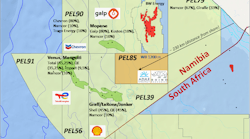The Enron Corp. bankruptcy protection filing may affect the ability of US pipeline companies to finance the expansions needed to meet dramatic increases in natural gas demand during the next decade.
An analysis prepared for the Interstate Natural Gas Association of America warned that pipeline operators would find it harder in the short term to raise capital they need to build projects.
The consulting firm Energy & Environmental Analysis Inc. (EEA) prepared the report for the INGAA Foundation. It updated a 1999 study that said companies should prepare to meet a 30 tcf gas market by 2010.
"Everyone's looking at their balance sheet," said Bruce Henning of EEA. Pipelines will need rates of return sufficient to attract required capital, wheth- er it is from outside investment or internally generated funds, he and other industry analysts cautioned.
But in the current economic climate, it's a difficult sell to expand or build a pipeline with gas prices soft and Wall Street wary of the industry, said El Paso Corp.'s Pipeline Group Pres. John Somerhalder.
"There is definitely momentum in the direction to delay projects," he said.
He added that two planned expansions of the company's Southern Natural gas pipeline were going ahead as scheduled, but the future of other proposals is less certain.
The EEA study said equity prices and bond ratings for a number of energy companies experienced substantial pressure following Enron's financial collapse.
Industry needs to continue building pipeline infrastructure to keep up with expanded gas growth, which may be just shy of 30 tcf by 2010 but will nevertheless still be robust, EEA officials said.
That means more than $67 billion in capital expenditures are needed by 2016, an average of $4.5 billion/year. In the 1999 study, analysts projected that about $2.6 billion/year would be needed. In the US alone, more than $47.7 billion, or $3.2 billion/year, is needed now, the study authors said.
EEA said a proposed pipeline to move North Slope Alaskan gas to the Lower 48 still is needed to serve expected demand, and a proposed pipeline from the Mackenzie Delta in Canada will also be necessary.
The study assumed the US recession would end by the third quarter. It also assumed US gross domestic product would grow 2.5%/year, with Canadian GDP at 2.2%/year through 2015. Oil prices would be $21/bbl in 2004, and then grow at 2%/year.
In a separate study, EEA reviewed gas-based emission control technologies for coal boilers.
That study said current environmental rules do not do enough to encourage utilities operating outdated coal-fired generating plants to invest in clean technology.
And possible reforms to power plant emission rules under the New Source Review standards should be crafted to better encourage utilities to retire older, more polluting coal-fired plants.
"We can't run forever on 60-year-old coal plants," said Joel Bluestein of EEA.
Some gas producers have said utilities will have no incentive to build gas-fired generation if revised environmental rules allow fewer constraints on older coal generators (OGJ Online, Jan. 9, 2002).
Meanwhile, refiners say the current NSR rules are capriciously enforced and discourage industry from expanding capacity for fear they will violate clean air rules.
